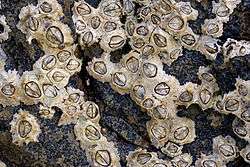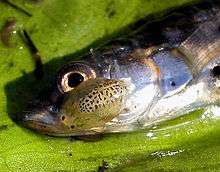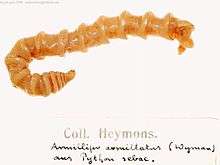Maxillopoda
| Maxillopoda Temporal range: Mid Cambrian–Recent | |
|---|---|
 | |
| Cyclops (Copepoda: Cyclopoida) | |
| Scientific classification | |
| Kingdom: | Animalia |
| Phylum: | Arthropoda |
| Subphylum: | Crustacea |
| Class: | Maxillopoda Dahl, 1956 [1] |
| Sub-classes | |
Maxillopoda is a diverse class of crustaceans including barnacles, copepods and a number of related animals. It does not appear to be a monophyletic group, and no single character unites all the members.[2]
Description
With the exception of some barnacles, maxillopodans are mostly small,[3] including the smallest known arthropod, Stygotantulus stocki.[2] They often have short bodies, with the abdomen reduced in size, and generally lacking any appendages.[3] This may have arisen through paedomorphosis.[3]
Apart from barnacles, which use their legs for filter feeding, most maxillopodans feed with their maxillae. They have a bauplan comprising 5 cephalic segments, 6 thoracic segments and 4 abdominal segments, followed by a telson.[4]
Fossil record
The fossil record of the group extends back into the Cambrian, with fossils of both barnacles[5] and tongue worms[6] known from that period.
Classification
Six subclasses are generally recognised, although many works have further included the ostracods among the Maxillopoda.[2] Of the six groups, only Mystacocarida are entirely free-living; all the members of the Tantulocarida, Pentastomida and Branchiura are parasitic, and many of the Copepoda and Thecostraca are parasites.
| Subclass | Members | Photo |
|---|---|---|
| Copepoda | Calanoida Cyclopoida Gelyelloida Harpacticoida Misophrioida Monstrilloida Mormonilloida Platycopioida Poecilostomatoida Siphonostomatoida |  Calocalanus pavo (Calanoida: Calocalanidae) |
| Thecostraca | Cirripedia (barnacles) Facetotecta Ascothoracida |  Chthamalus stellatus (Sessilia: Chthamalidae) |
| Branchiura | Arguloida (fish lice) † Cyclida |  Argulus on a stickleback (Argulidae) |
| Pentastomida (tongue worms) | Cephalobaenida Porocephalida Raillietiellida Reighardiida |  Armillifer armillatus (Porocephalidae) |
| Mystacocarida | Ctenocheilocaris Derocheilocaris | Ctenocheilocaris (Derocheilocarididae) |
| Tantulocarida | Basipodellidae Deoterthridae Doryphallophoridae Microdajidae |
See also
References
- ↑ "Maxillopoda". Integrated Taxonomic Information System. Retrieved 2016-09-10.
- 1 2 3 Joel W. Martin & George E. Davis (2001). An Updated Classification of the Recent Crustacea (PDF). Natural History Museum of Los Angeles County. p. 132.
- 1 2 3 "Introduction to Maxillopoda". University of California, Berkeley. Retrieved 2016-09-10.
- ↑ Phil Myers (2001). "Maxillopoda". Animal Diversity Web. Retrieved 2016-09-10.
- ↑ B. A. Foster & J. S. Buckeridge (1987). "Barnacle palaeontology". In A. J. Southward. Crustacean Issues 5: Barnacle Biology. pp. 41–63. ISBN 90-6191-628-3.
- ↑ Dieter Waloszek, John E. Repetski & Andreas Maas (June 2005). "A new Late Cambrian pentastomid and a review of the relationships of this parasitic group". Transactions of the Royal Society of Edinburgh: Earth Sciences. 96: 163–176. doi:10.1017/S0263593300001280.
External links
 Media related to Maxillopoda at Wikimedia Commons
Media related to Maxillopoda at Wikimedia Commons